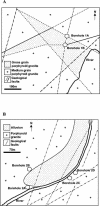Presence and persistence of Legionella spp. in groundwater
- PMID: 15691915
- PMCID: PMC546754
- DOI: 10.1128/AEM.71.2.663-671.2005
Presence and persistence of Legionella spp. in groundwater
Abstract
Groundwater samples (111) from six different boreholes located in two geographical areas were examined for the presence of legionellae over a 7-year period. The number of Legionella isolates detected was generally low. The colonization of the aquifers was not uniform, and the persistence of Legionella was independent of the hydraulic pumps and the plumbing system present in the borehole. A total of 374 isolates identified by fatty acid methyl ester analysis belonged to Legionella pneumophila, L. oakridgensis, L. sainthelensi, and L. londiniensis. In area 1, L. oakridgensis constituted the major population detected, exhibiting only one random amplified polymorphic DNA (RAPD)-PCR profile. L. sainthelensi strains were less frequently isolated and also displayed a single RAPD profile, while L. pneumophila was only sporadically detected. In contrast, L. pneumophila comprised the vast majority of the isolates in area 2 and exhibited six distinct RAPD patterns, indicating the presence of different genetic groups; three L. londiniensis RAPD types were also detected. Two of the L. pneumophila and one of the L. londiniensis RAPD types were persistent in this environment for at least 12 years. The genetic structure of L. pneumophila groundwater populations, inferred from rpoB and dotA gene sequences, was peculiar, since the majority of the isolates were allied in a discrete group different from the lineages containing most of the type and reference strains of the three subspecies of L. pneumophila. Furthermore, gene exchange events related to the dotA allele could be envisioned.
Figures




Similar articles
-
Molecular evolution of Legionella pneumophila dotA gene, the contribution of natural environmental strains.Environ Microbiol. 2010 Oct;12(10):2711-29. doi: 10.1111/j.1462-2920.2010.02240.x. Environ Microbiol. 2010. PMID: 20482739
-
Genetic diversity of Legionella pneumophila inferred from rpoB and dotA sequences.Clin Microbiol Infect. 2006 Mar;12(3):254-61. doi: 10.1111/j.1469-0691.2005.01338.x. Clin Microbiol Infect. 2006. PMID: 16451413
-
Population genetic structure of Legionella pneumophila inferred from RNA polymerase gene (rpoB) and DotA gene (dotA) sequences.J Bacteriol. 2002 Apr;184(8):2123-30. doi: 10.1128/JB.184.8.2123-2130.2002. J Bacteriol. 2002. PMID: 11914343 Free PMC article.
-
Diversity of legionellae strains from Tunisian hot spring water.Res Microbiol. 2013 May;164(4):342-50. doi: 10.1016/j.resmic.2013.01.002. Epub 2013 Feb 4. Res Microbiol. 2013. PMID: 23385143
-
Legionella pneumophila: population genetics, phylogeny and genomics.Infect Genet Evol. 2009 Sep;9(5):727-39. doi: 10.1016/j.meegid.2009.05.004. Epub 2009 May 18. Infect Genet Evol. 2009. PMID: 19450709 Review.
Cited by
-
Presence of Viable, Clinically Relevant Legionella Bacteria in Environmental Water and Soil Sources of China.Microbiol Spectr. 2022 Jun 29;10(3):e0114021. doi: 10.1128/spectrum.01140-21. Epub 2022 Apr 19. Microbiol Spectr. 2022. PMID: 35438512 Free PMC article.
-
Laboratory-based evaluation of legionellosis epidemiology in Ontario, Canada, 1978 to 2006.BMC Infect Dis. 2009 May 21;9:68. doi: 10.1186/1471-2334-9-68. BMC Infect Dis. 2009. PMID: 19460152 Free PMC article.
-
Legionella Occurrence beyond Cooling Towers and Premise Plumbing.Microorganisms. 2021 Dec 9;9(12):2543. doi: 10.3390/microorganisms9122543. Microorganisms. 2021. PMID: 34946143 Free PMC article. Review.
-
Differences in Virulence Between Legionella pneumophila Isolates From Human and Non-human Sources Determined in Galleria mellonella Infection Model.Front Cell Infect Microbiol. 2018 Apr 4;8:97. doi: 10.3389/fcimb.2018.00097. eCollection 2018. Front Cell Infect Microbiol. 2018. PMID: 29670859 Free PMC article.
-
Legionella species diversity and dynamics from surface reservoir to tap water: from cold adaptation to thermophily.ISME J. 2016 May;10(5):1064-80. doi: 10.1038/ismej.2015.199. Epub 2015 Nov 3. ISME J. 2016. PMID: 26528838 Free PMC article.
References
-
- Abu Kwaik, Y., L. Y. Gao, O. S. Harb, and B. J. Stone. 1997. Transcriptional regulation of the macrophage-induced gene (gspA) of Legionella pneumophila and phenotypic characterization of a null mutant. Mol. Microbiol. 24:629-642. - PubMed
-
- Adeleke, A. A., B. S. Fields, R. F. Benson, M. I. Daneshvar, J. M. Pruckler, R. M. Ratcliff, T. G. Harrison, R. S. Weyant, R. J. Birtles, D. Raoult, and M. A. Halablab. 2001. Legionella drozanskii sp. nov., Legionella rowbothamii sp. nov. and Legionella fallonii sp. nov.: three unusual new Legionella species. Int. J. Syst. Evol. Microbiol. 51:1151-1160. - PubMed
-
- Alli, O. A., S. Zink, N. K. von Lackum, and Y. Abu-Kwaik. 2003. Comparative assessment of virulence traits in Legionella spp. Microbiology 149:631-641. - PubMed
-
- Atlas, R. M. 1999. Legionella: from environmental habitats to disease pathology, detection and control. Environ. Microbiol. 1:283-293. - PubMed
Publication types
MeSH terms
Substances
Associated data
- Actions
- Actions
- Actions
- Actions
- Actions
- Actions
LinkOut - more resources
Full Text Sources
Molecular Biology Databases
Miscellaneous

